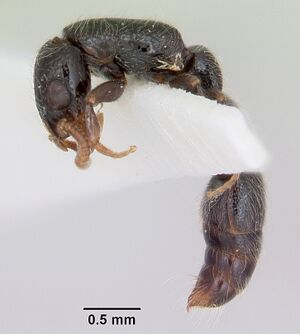Simopone annettae
| Simopone annettae | |
|---|---|

| |
| Scientific classification | |
| Kingdom: | Animalia |
| Phylum: | Arthropoda |
| Class: | Insecta |
| Order: | Hymenoptera |
| Family: | Formicidae |
| Subfamily: | Dorylinae |
| Genus: | Simopone |
| Species group: | schoutedeni |
| Species: | S. annettae |
| Binomial name | |
| Simopone annettae Kutter, 1976 | |
Specimens have been collected in forest habitats.
Identification
Key to Afrotropical Simopone Workers / Key to Known Afrotropical Simopone Queens
A member of the schoutedeni species group
Keys including this Species
Distribution
Latitudinal Distribution Pattern
Latitudinal Range: 5.583333333° to 5.516666667°.
| North Temperate |
North Subtropical |
Tropical | South Subtropical |
South Temperate |
- Source: AntMaps
Distribution based on Regional Taxon Lists
Afrotropical Region: Cameroun (type locality), Central African Republic, Democratic Republic of Congo, Gabon, Ghana.
Distribution based on AntMaps
Distribution based on AntWeb specimens
Check data from AntWeb
Countries Occupied
| Number of countries occupied by this species based on AntWiki Regional Taxon Lists. In general, fewer countries occupied indicates a narrower range, while more countries indicates a more widespread species. |

|
Estimated Abundance
| Relative abundance based on number of AntMaps records per species (this species within the purple bar). Fewer records (to the left) indicates a less abundant/encountered species while more records (to the right) indicates more abundant/encountered species. |

|
Biology
|
Castes
Worker
Images from AntWeb
    
| |
| Worker. Specimen code casent0173048. Photographer April Nobile, uploaded by California Academy of Sciences. | Owned by MCZ, Cambridge, MA, USA. |
Nomenclature
The following information is derived from Barry Bolton's Online Catalogue of the Ants of the World.
- annettae. Simopone annettae Kutter, 1976b: 273, figs. 1-8 (q.) CAMEROON.
- Type-material: holotype queen.
- Type-locality: Cameroon: Fo-Tabe (5°31’N, 9°35’E), 11.i.1937 (H. Kutter).
- Type-depository: NHMB.
- Bolton & Fisher, 2012: 18 (w.).
- Status as species: Bolton, 1995b: 383; Bolton & Fisher, 2012: 18 (redescription).
- Distribution: Cameroon, Central African Republic, Democratic Republic of Congo, Gabon, Ghana.
Unless otherwise noted the text for the remainder of this section is reported from the publication that includes the original description.
Description
Worker
Bolton and Fisher (2012) - PUTATIVE WORKER (not previously described). HL 0.79–0.86, HW 0.50–0.59, SL 0.23–0.28, EL 0.26–0.30, PW 0.39–0.45, AIIW 0.38–0.46, AIIL 0.37–0.44, AIIIW 0.45–0.56, AIIIL 0.46–0.56, WL 0.90–1.04, MFL 0.40– 0.46, CI 65–69, SI 43–48, EL/HW 0.48–0.51, EP 0.90–1.00, AIIW/AIIL 1.03–1.07, AIIIW/AIIIL 0.96–1.02 (5 measured).
With head in full-face view the outlines of the outer margins of the eyes fractionally fail to interrupt, or at most just interrupt, the outlines of the sides of the head at their midlength. ES 0.23–0.26 and width of head across broadest part of eyes 0.52–0.58. Frontal carinae extend back to level of anterior margins of eyes and are weakly divergent posteriorly. Cephalic dorsum with scattered broad, shallow punctures. Conspicuous ground sculpture is present between the eyes, organised into roughly longitudinal fine costulae or striolae between the punctures; ground sculpture fades out behind the level of the eyes. Leading edge of scape with a few setae, inclined toward the scape apex. Sides of head below and behind eyes with projecting short setae, inclined anteriorly. Cephalic dorsum with numerous short, curved setae and with a few pairs of longer setae present; longest setae occur on the frontal carinae and above the eye. Ventral surface of head with short setae. Mesosoma in dorsal view narrowest across the mesonotum (maximum width 0.37–0.46), broadest across the propodeum (maximum width 0.39–0.48). Anterior margin of pronotum weakly marginate. Propodeum with a fine weak carina between dorsum and declivity. Entire dorsum of mesosoma with widely spaced broad, shallow punctures. Mesopleuron with a few punctures and a distinct transverse sulcus. Propodeal declivity smooth except for a narrow band of disorganised superficial sculpture immediately below the dorsal carina. In profile, dorsal surfaces of mesosoma and all abdominal tergites with numerous posteriorly curved setae. Standing setae present on middle and hind tibiae. AII (petiole) in dorsal view with a weak transverse carina both anteriorly and posteriorly, the sides convex, broadest behind the midlength; the width across the anterior margin is somewhat less than across the posterior margin. Dorsum of AII with large, shallow punctures whose diameters are mostly equal to or greater than the distances that separate them. On tergite of AIII the punctures are of similar size but slightly more crowded, so that some are adjacent. AII broader than long, AIII about as broad as long, AIV distinctly broader than long (width 0.44–0.60, length 0.47–0.54; AIVW/AIVL 1.19–1.24). Head capsule and body black; scapes and funiculi light brown; femora and tibiae brown.
Queen
Bolton and Fisher (2012) - (alate gyne). Answers the description of the worker and is about the same size, but winged and with a full complement of flight sclerites. HL 0.90, HW 0.61, SL 0.29, EL 0.30, PW 0.49, AIIW 0.47, AIIL 0.45, AIIIW 0.56, AIIIL 0.63, CI 68, SI 48, EL/HW 0.49, EP 1.18, AIIW/AIIL 1.04, AIIIW/AIIIL 0.89; mesoscutum maximum width 0.52, mesoscutum maximum length 0.32.
Type Material
Bolton and Fisher (2012) - Holotype queen (alate), Cameroun: Fo-Tabe (9° 35’ östl. Länge, 5° 31’ nördl. Breite), 11.i.1937 (H. Kutter) (Naturhistorisches Museum, Basel) [examined].
References
- Bolton, B. & Fisher, B.L. 2012. Taxonomy of the cerapachyine ant genera Simopone Forel, Vicinopone gen. n. and Tanipone gen. n. (Hymenoptera: Formicidae). Zootaxa 3283, 1–101 (doi:10.11646/zootaxa.3283.1.1).
- Cantone S. 2018. Winged Ants, The queen. Dichotomous key to genera of winged female ants in the World. The Wings of Ants: morphological and systematic relationships (self-published).
- Kutter, H. 1976b. Beitrag zur Kenntnis der Gattung Simopone (Hym. Formicidae Subfam. Cerapachyinae resp. Ponerinae). Mitt. Schweiz. Entomol. Ges. 49: 273-276 (page 273, figs. 1-8 queen described)
References based on Global Ant Biodiversity Informatics
- Bolton B., and B. L. Fisher. 2012. Taxonomy of the cerapachyine ant genera Simopone Forel, Vicinopone gen. n. and Tanipone gen. n. (Hymenoptera: Formicidae). Zootaxa 3283: 1-101.

